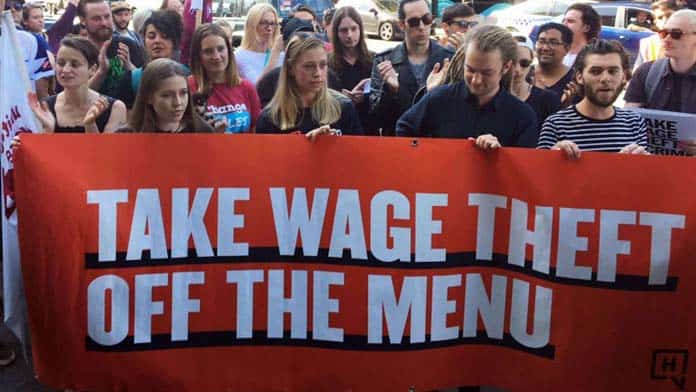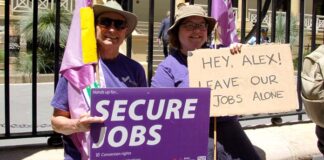Ben Schneiders is a Walkley award winning investigative journalist at The Age. His reporting has exposed more than two dozen companies for wage under-payment including some of the biggest names in corporate Australia.
His new book Hard Labour: wage theft in the age of inequality is out in October. He spoke to Solidarity’s David Glanz.
You start the book by talking about inequality, writing that the top 1 per cent in Australia control more wealth than the bottom 60 per cent of households combined. Why is this happening?
Over the longer term we’ve seen a dramatic change in the level of both income and wealth inequality in Australia.
We can see that more acutely in some other countries—such as the US where inequality is at levels last seen in the late 19th and early 20th century, the so-called Gilded Age of robber-barons.
The rich industrialised countries saw a dramatic shift in economic policy in the late 1970s and 1980s onwards, what’s commonly called neoliberalism, with a focus on free markets, deregulation, privatisation and similar policies.
I rely heavily on Thomas Piketty and his book Capital in the twenty-first century. It gives very detailed analysis using economic statistics of how the post-war period saw a great levelling and reduction in wealth and income inequality.
The wages share of income was at record highs in the late 1970s, there was a lot of industrial disputation and a problem, the way that business and government saw it, of unions being too powerful.
There was a seismic change from the 1980s onwards. In the US and the UK Thatcher and Reagan demolished the unions and aggressively cut corporate tax.
Australia is now in the top third of countries for income inequality in the OECD.
Here we had the Accord where unions agreed to real wage cuts and a reduction in industrial disputation in exchange for what was called the social wage, things like Medicare and increased welfare payments.
The floating of the dollar, and opening up of what was an economy with high tariffs and industry protection, all came from that period onwards.
How did you as a journalist first become aware of wage theft? And did you have any inkling about how many horror stories you were going to find?
Union officials and workplace lawyers who started their careers in the 1990s describe a very different kind of world where they just wasn’t this level of wage underpayment.
It’s clearly very different now 20 or 30 years later. I’d been the industrial relations reporter for The Age in the late 2000s, just after WorkChoices. Wage theft wasn’t something that people were talking about. Five later by 2015 that had really started to change.
I was looking at the treatment of temporary migrant workers, and got a tip-off from someone of Taiwanese background. I started looking at foreign language websites and jobs were being advertised regularly to people on temporary visas at half the legal rate.
And it was across all parts of the service or low-wage economy—nail salons, food courts, parts of construction.
Around the same time we saw the 7-Eleven expose by my colleague Adele Ferguson.
Since then you’ve seen wage theft exposed of hundreds of millions of dollars a year.
A big feature of hospitality is the systemic use of unpaid overtime, workers in restaurants doing 20 to 30 hours a week unpaid overtime. The scale of the underpayment there could easily be $600 or $800 a week if you were working a 60 or 70 hour week, which is common.
A second area was the wage deals between big businesses and the SDA. A researcher from the NTEU, Josh Cullinan, started looking at these deals and showed that there was significant wage underpayment.
The agreements were trading off workers’ penalty rates, overtime, casual rates for really small amounts of compensation. The net impact of that was wage theft of tens of millions of dollars every year at places like Coles, Woolworths, McDonald’s, the top three private sector employers in the country.
The SDA in cahoots with the employers was doing deals that left half the workforce every time, part-time workers and casuals, underpaid.
There’s a test in the Fair Work Act called the Better Off Overall Test, which is meant to ensure that you’re paid more than the minimum rates of the award.
Cullinan and a young trolley operator Duncan Hart challenged the Coles agreement in the Fair Work Commission and won.
All the agreements in the sector had to be renegotiated to comply with the award. At least a quarter of a million people were underpaid.
At Domino’s pizza Deutsche bank showed that the underpayment was $30 or $40 million a year.
The conditions on farms have been the worst in terms of bad labour conditions and underpayment anywhere in the country.
A lot of the workers are migrant workers. There are probably 100,000 people in Australia that are undocumented workers with no rights that are working on farms.
They are coerced into paying exorbitant fees for transport and accommodation, crammed many people to a room in the regional back blocks.
There’s still a lot of wage theft in the sector but the campaign from the mid-2010s by the United Workers Union (UWU), in an area that was regarded as next to impossible to organise, has had a lot of success. There’s now much more compliance with minimum wage laws and even attempts to bargain for agreements.
That helps challenge the common idea that migrant workers are somehow more submissive, more willing to take poor conditions or poor wages.
A lot of the people I got to know were migrant workers on temporary visas effectively organising themselves.
The UWU tapped into some incredible networks of people from Pacific Islands who worked together to ensure they were paid correctly.
There are as many as 21 universities currently under investigation for wage theft. What’s going on in this sector?
When you look at the university sector and compare it to other fields the levels of insecure work are just extraordinary. At every major Victorian university bar one, more than half the staff are on casual or fixed term contracts.
Funding to universities is part of the equation. But the NTEU make the reasonable point that all businesses have uncertain funding from year to year. University managements has responded to this by using much higher levels of temporary or insecure work than elsewhere.
You note in the book that unions today are not just smaller than in the 1970s, but that, “they’re exhausted after decades of decline and attacks. There is little optimism or energy among them.” What do you think needs to happen to rebuild numbers, density and fighting spirit?
As a whole I think the movement has been exhausted, there’s been decades of restrictions on organising and anti-union laws. Unions that were historically very important are a shadow of their former selves. Manufacturing has diminished as a part of the Australian economy and the AMWU now only has tens of thousands of members nationally.
I think the union movement has had too much of a focus on party politics and parliamentary outcomes. Resources need be pushed into some of the hard to organise industries. The farm workers campaign would have cost the UWU a lot of money. But the reason for unions’ existence is to organise exploited workers, and improve their lives.
Changes to workplace law and attacks on organised labour under the Howard government such as the waterfront dispute in 1998 that reduced the influence of the MUA, and later attacks on the CFMEU, have also weakened unions.
Barely 10 per cent of the workforce in the private sector are now in a union, back in the 1980s it was more like half the workforce.
There’s no question that there’s been a decline but it’s also clear that people join unions when they think they are going to fight and there’s a chance of winning. Unions always report big increases in membership when they actually take part in struggle and at the core of that is the willingness to take on the law and take back the right to strike.
You were part of a similar show of defiance at The Age, where union members went on strike in defiance of the law without actually receiving any fines.
In the media industry from 2008 there were really significant job losses at what was Fairfax media where I worked, now owned by Channel Nine. We had several strikes during that period and all of them were unlawful. We would just walk off the job almost in protest at what we saw as the gutting of our newsrooms and what was being done to our colleagues.
The most significant of those strikes was in 2017 when we walked off for a week.
By the letter of the law, we could have been individually prosecuted and the MEAA could have been prosecuted as well.
Over the last decade, there’s been very few nationally important strikes.
But it does feel like there’s a shift in mood and we’re seeing more industrial action.
In unionised sectors we’re starting to see more and larger wage claims due to high inflation where people are pushing back against reductions in living standards. You’ve seen some significant rebellions in the US, including at Amazon in New York, and big public sector strikes here as well.
Whether that manifests itself into something bigger and broader is the question.
Hear the full interview below.






